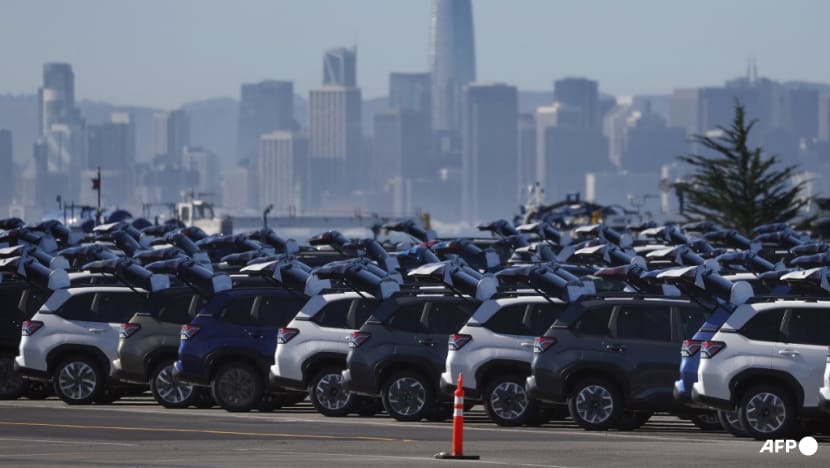- Joined
- Aug 20, 2022
- Messages
- 21,627
- Points
- 113
The 'Dirty 15' economies that could be hardest hit by Trump's reciprocal tariffs
Some economies, including several in Asia, are expected to be hit harder than others.
01 Apr 2025 12:53PM (Updated: 01 Apr 2025 01:40PM)
US President Donald Trump has joked that "tariff" is one of his favourite words, and on Wednesday (Apr 2), he is set to announce a slew of "reciprocal tariffs" that would shake up global trade.
The idea is to address what Trump says are unfair trade imbalances because the US imports more goods than it exports.
While the details of Trump's next round of import taxes are still sketchy, some economies are expected to be hit harder than others.
The “Dirty 15”, in particular, has drawn scrutiny.
Coined by Treasury Secretary Scott Bessent, the term refers to the 15 per cent of economies that account for the bulk of trade imbalances with the US while imposing steep tariffs and other non-tariff barriers on US goods.
Bessent did not name these 15 trading partners but according to data from the US Department of Commerce, China had the greatest trade surplus with the US in 2024, at US$295.4 billion.
This was followed by the European Union, Mexico, Vietnam, Ireland, Germany, Taiwan, Japan, South Korea, Canada, India, Thailand, Italy, Switzerland and Malaysia.
Some of these economies have made efforts to appease the US ahead of the tariffs announcement.
Vietnam, which had a US$123.5 billion trade surplus with the US in 2024, inked US$4 billion in energy and minerals deals with US firms when its trade minister recently visited Washington.
The "highly meaningful" deals were aimed at establishing "balanced and harmonious" trade and would create hundreds of thousands of jobs for workers in both countries, said PetroVietnam Power Corporation.
India’s commerce and industry minister made multiple trips to the US to work out key issues, with the country reportedly open to cutting US$23 billion worth of tariffs on US imports.
South Korea has also sent its industry ministry to Washington to seek relief while activating its emergency strategy.
Taiwan, which saw a US$26.1 billion increase in its trade surplus with the US, said previously that it is considering a variety of responses to potential new tariffs from the US, including increasing energy imports and reducing the island's own tariffs to balance bilateral trade.
Its central bank has defended the island's trade and currency record, saying the high current account surplus was a structural problem and Washington understood that.
It is possible that Trump's tariffs would be short-lived if he feels he can cut a deal after imposing them.
“I’m certainly open to it, if we can do something," Trump told reporters. "We’ll get something for it.”
Trump says he will be 'kind' with tariffs as deadline looms
Commentary: Nightmare scenario as Trump’s tariffs head for Asia
TRUMP’S HISTORY WITH TARIFFS
Trump has hyped up his impending announcement on reciprocal tariffs as Liberation Day because his policies aim to free the US economy from dependence on foreign goods.“We’re going to charge countries for doing business in our country and taking our jobs, taking our wealth, taking a lot of things that they’ve been taking over the years," Trump said last week when he announced 25 per cent auto tariffs.
“They’ve taken so much out of our country, friend and foe. And, frankly, friend has been oftentimes much worse than foe.”
Trump's displeasure with trade ties between the US and the global economy can be traced back to the 1980s.
In an interview with CNN’s Larry King in 1987, when he discussed getting into politics, Trump said: “A lot of people are tired of watching other countries ripping off the US.”
He added: “Behind our backs, they laugh at us because of our own stupidity.”
While the main target of his ire at the time was Japan, China entered his crosshairs by the 1990s and early 2000s, and Beijing remains one of his top tariff targets, along with Canada, Mexico and the EU.
In his successful 2016 election campaign, Trump stepped up the rhetoric, saying: "We can't continue to allow China to rape our country."
In 2018, he declared in a social media post that he was a "Tariff Man".
During his second term, Trump also started citing a historical precedent going back more than a century - President William McKinley.
McKinley's passion for both territorial expansion and economic protectionism during his time in office from 1897 to 1901 could have been the model for Trump's "Make America Great Again" policies.
"President McKinley made our country very rich through tariffs and through talent - he was a natural businessman," Trump said in his inauguration speech in January.
America’s tariffs are generally lower than those of its trading partners. After World War II, the US pushed for other countries to lower trade barriers and tariffs, seeing free trade as a way to promote peace, prosperity and American exports around the world.
And it mostly practised what it preached, generally keeping its own tariffs low and giving American consumers access to inexpensive foreign goods.
Trump has broken with that free trade consensus, saying unfair foreign competition has hurt American manufacturers and devastated factory towns in the American heartland.
Most economists say nothing good would come out of scrambling the tariff code.
They say the tariffs would get passed along to consumers in the form of higher prices for autos, groceries, housing and other goods. Corporate profits could be lower and growth more sluggish.
Trump maintains that more companies would open factories to avoid the taxes, although that process could take three years or more.






